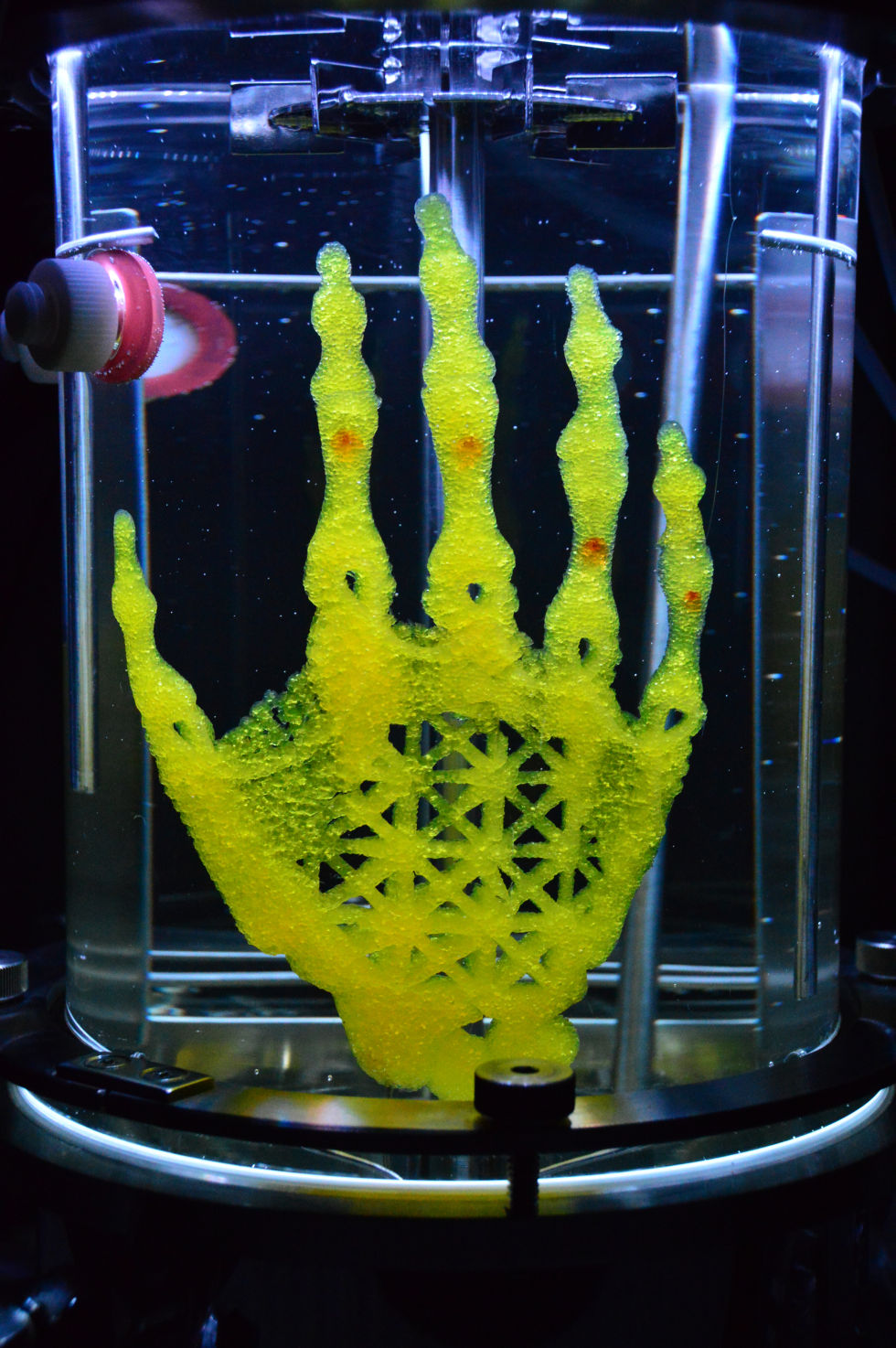


AMY KARLE
regenerative reliquary
Leveraging the intelligence of human stem cells, she created “Regenerative Reliquary”, a bioprinted scaffold in the shape of a human hand design 3D printed in a biodegradable pegda hydrogel that disintegrates over time. The sculpture is installed in a bioreactor, with the intention that human Mesenchymal stem cells (hMSCs from an adult donor) seeded onto that design will eventually grow into tissue and mineralize into bone along that scaffold.

Tomas Saraceno
Moving atmospheres
Moving Atmospheres, the tenth Garage Atrium Commission curated by Iaroslav Volovod, is a partially mirrored sphere suspended in the air, propelling us towards an Aerocene epoch. We call towards this new era with Aerocene. For more than a decade we have been imagining a world free from the carbon, extractivism, capitalism and patriarchy that fuels some forms of life, a new way of being with the atmosphere and emissions-free travel, free from solar panels, lithium, helium, hydrogen and fossil fuels. This new era stands in stark contrast to the lingering eco-traumas of the Anthropocene, the current geological age in which some human capitalistic activity has been the dominant influence on climate and the environment.

AZUMA MAKOTO
あずままこと
אזאמה מקוטו
아즈마 마코토
Адзума Макото
Water and Bonsai
In his continued forays into experimental botany that blur the lines between art and science, artist Makoto Azuma (previously) has reimagined the bonsai tree, one of the oldest Japanese artforms. This latest work titled Water and Bonsai, began with a dead branch from a juniper tree which was carefully attached to java moss meant to simulate the form of leaves. The entire piece was then submerged into a modified hydroponic environment similar to some of his earlier aquatic plantscapes replete with LEDs, a filtration system, and C02 emissions that encourage photosynthesis.
.

Jun Kamei
Amphibio
AMPHIBIO is made out of a special porous hydrophobic material which supports underwater breathing by replenishing oxygen from the surrounding water and dissipating carbon dioxide which accumulate in the system, inspired from the gill of water diving insects. The material can be shaped in complex form using 3D printing. Patent pending.

Philip Glass
with Allen Ginsberg
Hydrogen Jukebox
The creation of the chamber opera Hydrogen Jukebox can be traced to a chance meeting in 1988 between composer Philip Glass and poet Allen Ginsberg at the now defunct St. Mark’s Bookshop in New York City’s East Village. When Ginsberg plucked a book with a copy of his 1966 antiwar poem “Wichita Vortex Sutra” off the shelf and said he’d be reading it at a Broadway theater, Glass decided to compose a piano piece to accompany the reading. The collaboration was a success, so the two decided to expand the performance into a longer music-theater work. The result, Hydrogen Jukebox, a rarely performed piece for six voices and a chamber ensemble[…]

CERN
Globe of Science and Innovation
History of the universe
Did you know that the matter in your body is billions of years old?
According to most astrophysicists, all the matter found in the universe today — including the matter in people, plants, animals, the earth, stars, and galaxies — was created at the very first moment of time, thought to be about 13 billion years ago.
The universe began, scientists believe, with every speck of its energy jammed into a very tiny point. This extremely dense point exploded with unimaginable force, creating matter and propelling it outward to make the billions of galaxies of our vast universe. Astrophysicists dubbed this titanic explosion the Big Bang.
The Big Bang was like no explosion you might witness on earth today. For instance, a hydrogen bomb explosion, whose center registers approximately 100 million degrees Celsius, moves through the air at about 300 meters per second. In contrast, cosmologists believe the Big Bang flung energy in all directions at the speed of light (300,000,000 meters per second, a million times faster than the H-bomb) and estimate that the temperature of the entire universe was 1000 trillion degrees Celsius at just a tiny fraction of a second after the explosion. Even the cores of the hottest stars in today’s universe are much cooler than that.
There’s another important quality of the Big Bang that makes it unique. While an explosion of a man-made bomb expands through air, the Big Bang did not expand through anything. That’s because there was no space to expand through at the beginning of time. Rather, physicists believe the Big Bang created and stretched space itself, expanding the universe.




INVISIBLE CAR
MERCEDES-BENZ “Invisible Drive”
The Mercedes-Benz F-CELL is the first hydrogen-powered car, which is ready for series production. With a spectacular action we draw a suitable attention to this innovation: We made people experience F-CELL the same way the environment does – like it’s not even existent. In practice: We disguised the B-Class F-CELL with mats out of LEDs on the one side and fixed a camera on the other side of the car. The camera filmed everything that happened behind the vehicle and transferred every action directly to the LED mats. The effect: The B-Class fused completely with its surrounding and became invisible for the passersby in the immediate vicinity.